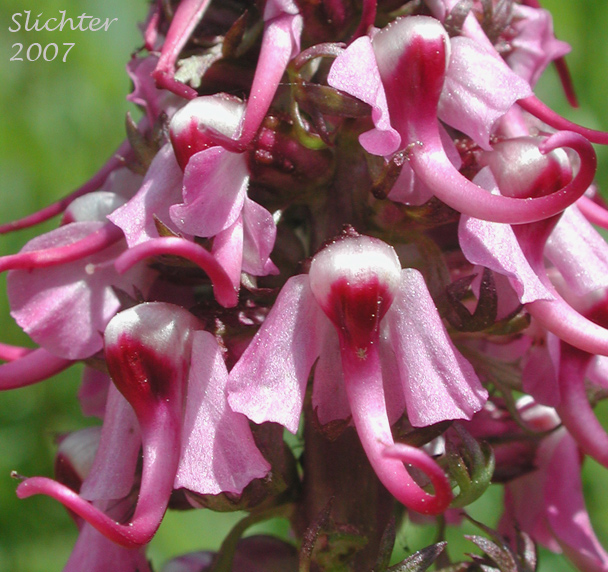[Louseworts: The Genus Pedicularis East of the Cascade
Mts. of Oregon and Washington]
Bull Elephant's-head, Elephanthead Lousewort, Elephant's Head, Elephant's Head Pedicularis, Pink Elephant's Head
Pedicularis groenlandica
Synonyms: Elephantella groenlandica, Pedicularis groenlandica ssp. surrecta, Pedicularis groenlandica var. surrecta

The photo above shows a close-up of the flower of elephant's head as seen from
wet meadows along Butcher Bill Creek about one mile west of Penland Lake in the Umatilla National Forest........June 22, 2007. The resemblance to an elephant's head and trunk can easily be noticed here.
 The photo at right shows a close-up of the flowers of elephant's head as seen from wet meadows along Butcher Bill Creek about one mile west of Penland Lake in the Umatilla National Forest........June 22, 2007.
The photo at right shows a close-up of the flowers of elephant's head as seen from wet meadows along Butcher Bill Creek about one mile west of Penland Lake in the Umatilla National Forest........June 22, 2007.
Characteristics:
Elephant's head is an interesting and
beautiful perennial wildflower. It ranges in height from 15 to 70 cm tall. Multiple
stems arise from the basal leaves, which are compound pinnate in structure.
The blade of each leaf is roughly equal or greater in length than the petiole,
with the entire leaf ranging in length from 5 to 25 cm long. The blades range
from 5 to 40 mm wide. The individual leaflets or pinnae are narrow and sharply
toothed. The few leaves found on the stems are much reduced in size, but similar
in outline to the basal leaves, but with much shorter petioles.
The inflorescence is elongate, with interesting pink flowers
densely packed at the upper fourth of the stem. The five sepals are united into
a narrow cup, with five unequal lobes. The pink to almost red corolla consists
of unequally sized and shaped petals, with the lower lip smaller than the upper.
The galea is hooded and tipped with a long, slender and upturned beak or spur,
reminiscent of an elephant's trunk. Individual flowers are about 13 mm in length.
Habitat:
Elephant's head grows in moist meadows and occasionally in small
cold streams from moderate to high elevation in the mountains.
Range:
Elephant's heads are a widespread species which may be found
in mountainous areas from British Columbia south through Washington and Oregon
to California, and eastward through Alberta to Labrador, and south from Alberta
through the Rockies to New Mexico.
 -
-  -
- 
The photo at left shows several elephant's heads as seen from wet meadows along Butcher Bill Creek about one mile west of Penland Lake in the Umatilla National Forest.......June 22, 2007. Other plants present at this site included sitka burnet and white bog orchids. The photos at center and right shows elephant's heads along the shoreline of Maxwell Lake, Eagle Cap Wilderness..........August 3, 2016.
 -
- 
A field of elephant's heads blooming in moist meadows at Summit Prairie, Malheur National Forest........June 23, 2011( left) and at the same location on May 28, 2014 (right).
 -
- 
Elephantheads blooming at left in a wet area along Forest Road 4011 several hundred yards below the trailhead for the Crane Mountain Trail, Fremont-Winema National Forest......June 30, 2019. The photo at right shows elephantheads in bloom in moist meadows adjacent to the trailhead for the Deadman Canyon Trail #1869 at the north end of the Fish Lake Campground, Wallowa-Whitman National Forest......July 18, 2019.
 -
- 
Elephantheads beginning to bloom at left in wet sedgelands along the Hanan Trail #142 about a mile or so below the headwaters of the Sycan River, Fremont-Winema National Forest......June 17, 2020. The photo at right shows elephantheads in bloom in a moist meadow on the east side of the Fremont National Recreation Trail #160 at Hank's Spring, northwest side of Twelvemile Peak, Fremont-Winema National Forest.....July 16, 2022.
 -
-  -
- 
The photo at left shows an elephanthead in bloom in wet meadows around High Lake, Strawberry Mountain Wilderness......July 8, 2023. The photos at center and right show the habitat and the inflorescence of elephantheads as seen in a moist meadow near the north end of the Roads End Trail #201, Malheur National Forest......July 7, 2023.

A close-up of elephant's head from Fish Lake, Steens Mt., southeastern
Oregon........June 26, 2000.

Paul Slichter
 The photo at right shows a close-up of the flowers of elephant's head as seen from wet meadows along Butcher Bill Creek about one mile west of Penland Lake in the Umatilla National Forest........June 22, 2007.
The photo at right shows a close-up of the flowers of elephant's head as seen from wet meadows along Butcher Bill Creek about one mile west of Penland Lake in the Umatilla National Forest........June 22, 2007. 